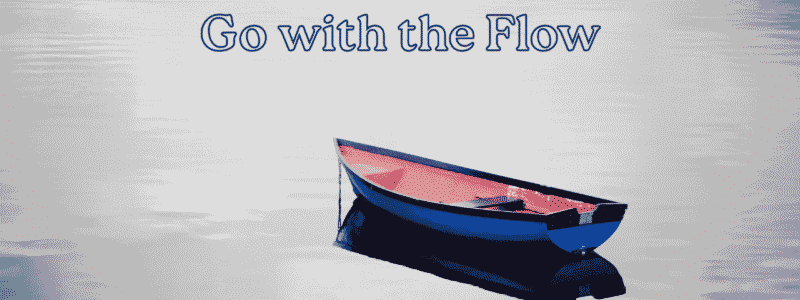Why Going With the Flow Makes More Sense on Most Days
Life has often been compared to a river. Some days we paddle hard against the current, determined to reach our chosen shore. Other days, we allow ourselves to drift, trusting that the flow will take us somewhere meaningful. While modern culture often glorifies “fighting the current” or “choosing your own path at all costs,” research — and human experience — suggests that going with the flow most of the time is not only healthier, but also more effective.
The Ease of Flow
The term “flow” is nowadays mostly used to talk about work.
Psychologist Mihaly Csikszentmihalyi coined the term “flow” to describe a state of complete absorption in what we are doing — where challenge meets skill, and effort feels almost effortless. In his landmark book Flow: The Psychology of Optimal Experience (1990), he found that people who reported more “flow states” also reported higher levels of happiness, satisfaction, and productivity.
But we are not talking of flow in a larger context here. What we are saying is that by aligning ourselves with the flow of circumstances — instead of constantly resisting them — we create conditions for this ease and harmony to emerge.
Flow is not simply a mental state. It is, rather, a stance toward life itself. Instead of always wrestling with what ‘should be,’ we need to lean into ‘what is,’ trusting that the current is not always our enemy but often our guide.
In the short-term, day-to-day sense, this looks like choosing ease over resistance in small ways:
- Accepting that traffic is slow instead of raging at it
- Letting a conversation unfold naturally rather than steering it forcefully
- Allowing your schedule to breathe when a child, a friend, or even your own body asks for attention
These micro-decisions, accumulated, shape our days and ultimately our life. By aligning ourselves with the natural flow of circumstances, we reduce friction and create conditions where peace, clarity, and harmony are more likely to emerge — not just in isolated moments of work, but across the unfolding of a life.
Why Going With the Flow Works
Research has shown that choosing to let life dictate where we go helps us lead more rewarding and stress-free lives. A quick look then what research says:
- Reduced Stress
- Chronic resistance to what life throws at us keeps our stress hormones elevated
- A study by Lazarus & Folkman (1984) on stress and coping showed that acceptance-focused coping strategies often reduced anxiety more effectively than constant problem-focused strategies
- Energy Conservation
- Fighting the current burns energy. In neuroscience, this is described as ego depletion (Baumeister et al., 1998), where self-control and willpower are limited resources
- By choosing to flow more often, we save energy for when it really matters
- Greater Adaptability
- Evolution favours adaptability. People who can adjust to external conditions — rather than rigidly control them — tend to thrive across changing environments (Bonanno, 2004, on resilience)
- Going with the flow means staying flexible, like water in Bruce Lee’s famous metaphor: “Be water, my friend.”
When Paddling Against the Flow Matters
Of course, always going with the flow risks complacency. Sometimes, choosing differently is necessary for breakthroughs:
- Gandhi said no to the Asiatic Ordinance of 1906, which required Indians to register with fingerprints and show certificates to police. This started the non-cooperation movement
- Claudette Colvin refused to give up her bus seat and planted the seed of the boycott – made famous nine months later by Rosa Parks – and kickstarted the US Civil Rights Movement
- Galileo Galilei’s defence of heliocentrism, the idea that the Earth revolves around the Sun, shook the Catholic Church and academia
Research shows that strategic non-conformity can lead to innovation and social progress. Grant & Hofmann (2011) found that employees who constructively deviated from norms were often the drivers of positive organisational change.
What needs to be noted here is that these acts were not everyday resistance — they were carefully chosen moments of standing firm against the tide.
The Balanced Wisdom
So, what does this mean for everyday living?
- Most days: Align yourself with the current. Save your strength. Allow the rhythm of life to carry you. This builds peace, resilience, and joy
- Some days: Paddle hard against it. When your values, dreams, or integrity are at stake, those are the moments when resistance creates transformation
Final Reflection
Life is not about always controlling the river or always surrendering to it. It’s about wisdom: knowing when to go with the flow and when to row against it. Going with the flow most of the time doesn’t mean giving up — it means trusting that you don’t need to fight every battle. And when you do choose to fight, your strength will be greater, your purpose clearer, and your impact deeper.
References
- Baumeister, R. F., Bratslavsky, E., Muraven, M., & Tice, D. M. (1998). Ego depletion: Is the active self a limited resource? Journal of Personality and Social Psychology, 74(5), 1252–1265.
- Bonanno, G. A. (2004). Loss, trauma, and human resilience: Have we underestimated the human capacity to thrive after extremely aversive events? American Psychologist, 59(1), 20–28.
- Csikszentmihalyi, M. (1990). Flow: The Psychology of Optimal Experience. Harper & Row.
- Grant, A. M., & Hofmann, D. A. (2011). It’s not all about me: Motivating hand hygiene among health care professionals by focusing on patients. Psychological Science, 22(12), 1494–1499.
- Lazarus, R. S., & Folkman, S. (1984). Stress, appraisal, and coping. Springer.

